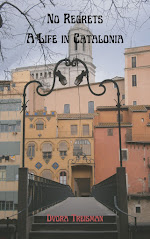It took over a week to get back there and by that time the yellow fields had been harvested. But never mind, the village was still there.
I couldn’t find a founding date for the village, but I did discover that there are documents as early as 957 that indicate that the name of the village was a composite of a Latin word and a Germanic word, put together they said Village of Peace which eventually evolved to Vilafreser.
I saw no school, no city hall (it is within the jurisdiction of the nearby village of Vilademuls -- I’ll have to visit there too, one of these days), no shop, and no bar, but it does have 99 inhabitants and a church, dedicated to Sant Sadurni, some part of which already existed in 1058.
The masia Can Divi was built in the 16th century.
Another masia, Can Ramon, for which I have no photo, has a lintel that says 1616. I read on the city hall website that it also had another lintel, since removed, that had a Hebrew inscription, suggesting (to the city hall) that there was a Jewish colony in the area. Well, the general area had an extensive Jewish population. Castelló d’Empúries has a street named Carrer Jueu (Jewish Street); Vilajuiga means Jewish village, Besalù has the remains of the medieval mikvah. Girona, only 20 kilometers away, had a substantial and very important medieval Jewish community. Its synagogue was home to the famous rabbi Moses ben Nachman, commonly known as Nachmanides or Ramban and ancestor of Avi, a good friend of mine. He was a leading medieval Jewish scholar, Sephardic rabbi, philosopher, physician, kabbalist, and biblical commentator. But that was in the middle ages. The Jews were thrown out in 1492.
Unless that house precedes the expulsion, how that lintel got there is anyone’s guess. It could have been salvaged. In Barcelona there are Jewish headstones taken from what was a Jewish cemetery on Montjuic (Jewish Mountain), that were reused as building stones. One is located in a wall just alongside the cathedral.
In addition to beautiful stone buildings, you can find wild asparagus growing around Vilafreser if, like this fellow, you know where to look.





















Looks lovely and the history lesson was great.It is wonderful to have nearby places of interest to wander about in occasionally.
ReplyDeleteThanks, Elaine.
Delete